Many can't believe the long list of amazing performers and speakers who have appeared at Kent State University’s Memorial Athletic and Convocation Center, otherwise known as “the MAC Center.” It’s likely that every alumnus has a memory of a performance or special event that they attended during their time at Kent State.
The venue began its life in 1950 as the Men’s Physical Education Building, initially supplementing and then replacing Kent State’s Willis Gymnasium. Built on a hill overlooking Memorial Stadium, it was one of several on-campus projects built in response to increased enrollment following World War II, due in large part to returning veterans attending Kent State through the GI Bill. The facility was rededicated in 1956 as the Kent State Memorial Gym to honor Kent State students who lost their lives in World War I and WWII.
A Very Impressive List of Performers
For the most part, the performers, speakers and musicians who appeared at the Men’s Physical Education Building/Memorial Gym/Memorial Athletic and Convocation Center through the years are reflective of the tastes and interests of the students of Kent State at the time.
Jason Prufer, ’03, assistant service desk coordinator at Kent State University Libraries and the author of the book “Small Town, Big Music: The Outsized Influence of Kent, Ohio, on the History of Rock and Roll,” added his insights and memories in collecting the long list of events at this venue. He said that, particularly with the musical acts, the students guided which ones came to campus, through student organizations, first the University Social Committee, then the Major Events Committee, the All-Campus Programming Board and now, the Undergraduate Student Government.
“It was definitely the students,” Prufer said. “Because they were the ones who would know what was cool to bring. The thing about university students is they always know what’s cool first and they bring the cool stuff here first before it blows up.”
Kent State was fortunate to welcome many performers during their up-and-coming and prime years of their careers. Location was a factor in that Ohio is “on the way” between New York and Chicago, making it a convenient spot to pick up a gig. Plus, Kent State’s spacious new building was one of the larger indoor venues on that route, until the Coliseum opened in Richfield, Ohio, in 1974.
Smart financial planning also played a role in bringing big acts. Starting out, the student organizations that booked events had generous budgets to work with. By charging admission to the shows, they could recover what they paid to book the performers and, with profits from the shows, use the added funds to bring even bigger acts to campus.
The 1950s
Throughout the 1950s and early 1960s, the events hosted at the Memorial Gym were mainly associated with Fall Homecoming and Campus Day, which was like a second, annual homecoming celebration in the spring. Famous big band leaders and their orchestras entertained students at dances.
Jan. 11, 1954, Former First Lady Eleanor Roosevelt speaks at the Men’s Physical Education Building.
All classes were canceled the day of Roosevelt’s speech. All students were required to attend the event.
In her “My Day” syndicated newspaper column a few days later, Roosevelt recounts that she was personally escorted to the gym by Kent State President George Bowman and was impressed by the large venue. “If the microphone had not been there, I would have been seriously troubled about whether my voice could reach into the far corners of the building,” she wrote. She was impressed by the academic programs offered by the university and wrote, “The courses given at Kent fill the needs of a great many young people.”
Oct. 26, 1957, Duke Ellington and his orchestra
For this sell-out homecoming show, the band was moved to a platform above the pool to leave room for students to dance. The pool was located under a retractable floor section where the MAC Center ticket lobby is now. Ellington had just completed session work on a new album 15 days prior to this event, so some of the music they played that night had likely not been heard before.
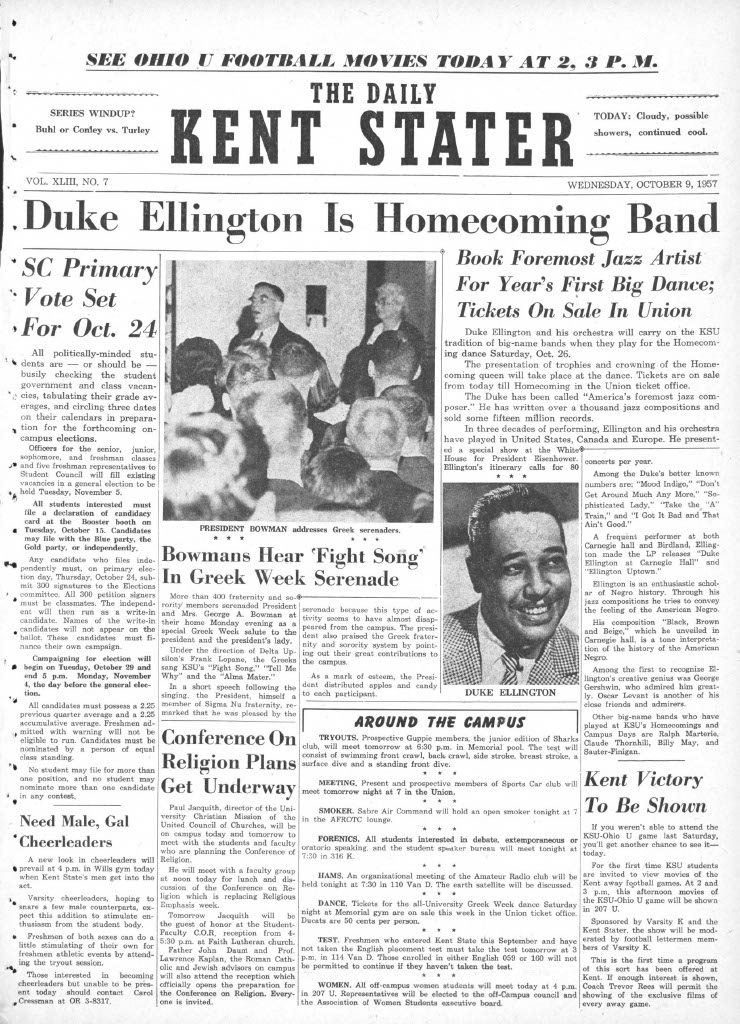
The 1960s
In the 1960s, the performers invited to campus began to slowly reflect the changing times as popular music moved from big bands to pop to rock and roll, and dances became concerts. The decade's beginning with the Sammy Kaye Orchestra is in sharp contrast to the decade’s end with Sly and the Family Stone.
May 13, 1967, Sammy Davis Jr.
When Davis Jr. came to Kent, local businessmen threw a party for him downtown, inviting local business and government officials. In what Davis Jr. called "one of the warmest receptions I have ever received on a concert tour,” he received a gold Kent State sweatshirt, with the hope that he’d wear it while filming his next movie. Davis Jr. was also inducted as an honorary member of Kent State’s Alpha Epsilon Pi fraternity chapter.
The 1970s
Throughout the 1970s, the Memorial Gym saw performances from top entertainers whose names are still familiar today. Some of the biggest acts were brought here by the All-Campus Programming Board while Michael D. Solomon was its chairman from 1972-1974. “He came at the right time and was absolutely driven with all his shows,” said Prufer. Prufer also added that initially, the concerts paid for with student funds were not meant to turn a profit. But the programming board realized that if a performance generated profit, they could use those funds to invest in more shows. “And that’s why through the 70s, you see these smash shows.” Some of the biggest shows of the decade at Kent State - Elton John, Pink Floyd, Bruce Springsteen, The Eagles - came at the end of the year when the programming board used their remaining profits to bring in top performers.
Solomon graduated from Kent State’s Class of 1974 with a business degree and went on to work with early stage technology companies. He maintained a strong connection to his alma mater, and in 2001, he endowed the Michael D. Solomon Entrepreneurship Speaker Series at Kent State’s Ambassador Crawford College of Business and Entrepreneurship. In 2011, Solomon was named the university’s first National Trustee on the Kent State University Board of Trustees.
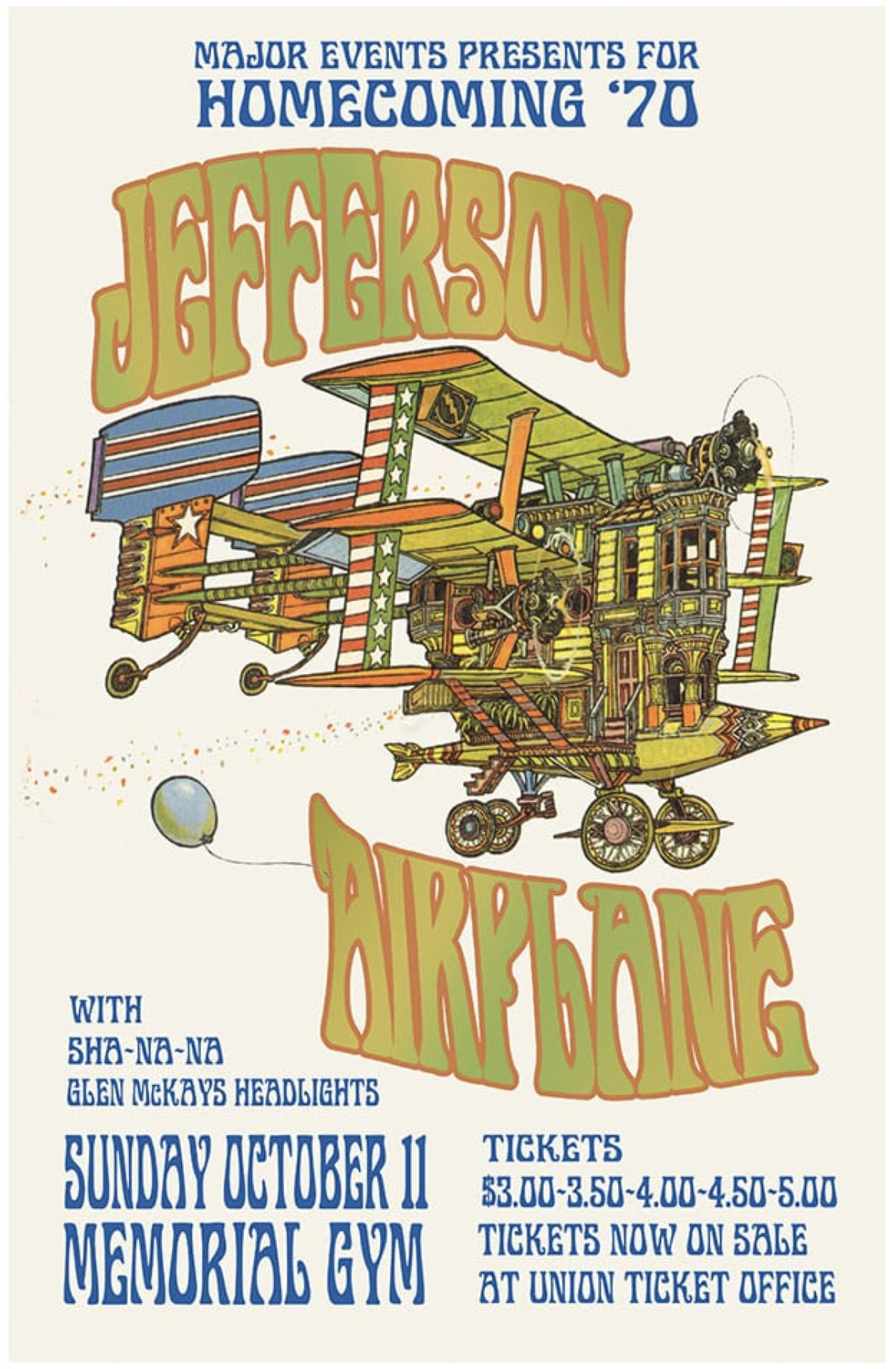
Oct. 11, 1970, Jefferson Airplane with Sha Na Na
Prufer said that this show was important, as it was the first “big” concert on campus after May 4. The choice of performers was big, also. “It’s just Jefferson Airplane – the most revolutionary,” Prufer said. “No administrators would have booked Jefferson Airplane. That was all the students.” There are photographs of Jack Casady [bass player for Jefferson Airplane] backstage, and the tower [of the] University Library is visible through the window in the background because it was before the Kent Student Center had been built. “And I know that Grace (Slick) was pregnant during that show with Chyna,” he said. “The band was fantastic. If you listen to recordings from that period, they were just explosive.”
March 10, 1973, Pink Floyd
Pink Floyd hit the stage at Kent State at a key point in their history - just nine days after the release of their breakthrough “Dark Side of the Moon” album. That album remained the best-selling album of all time for more than seven years after its release.
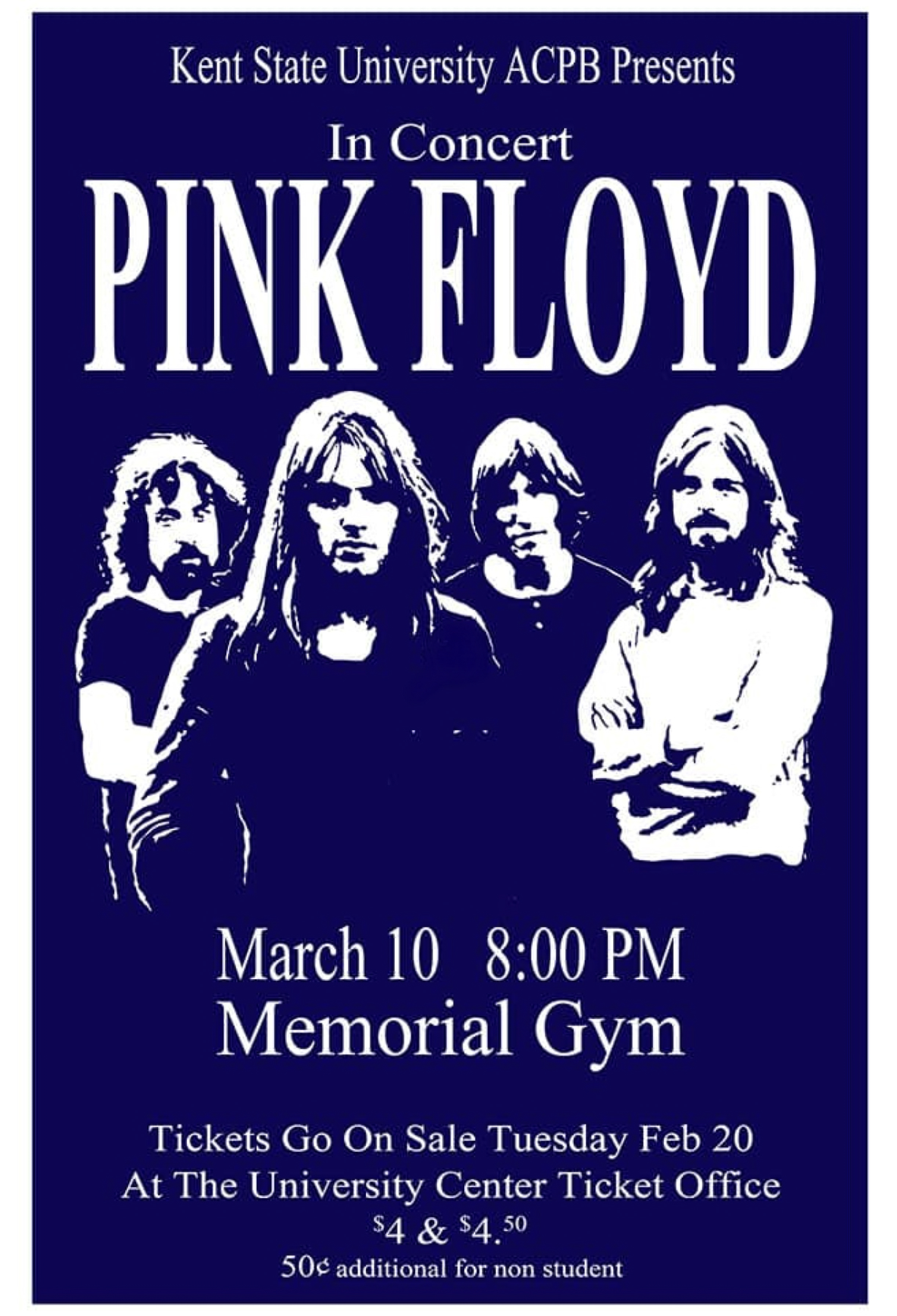
May 3, 1975, the Eagles and Dan Fogelberg
There was an immediate, negative reaction from students, faculty and administrators when the All-Campus Programming Board announced that the Eagles were coming to Kent State. The concert was scheduled on May 3, the day before the five-year anniversary of the Kent State tragedy at the same time the traditional candlelight vigil would be held. The ACPB spoke with the Eagles and were assured that the concert and encores would conclude before 10:30. In tribute to the commemoration, Dan Fogelberg included a cover of Buffalo Springfield’s “For What It’s Worth” in his set list and the Eagles performed “Ohio” by Crosby, Stills, Nash and Young. Members of the Eagles also attended the candlelight vigil.
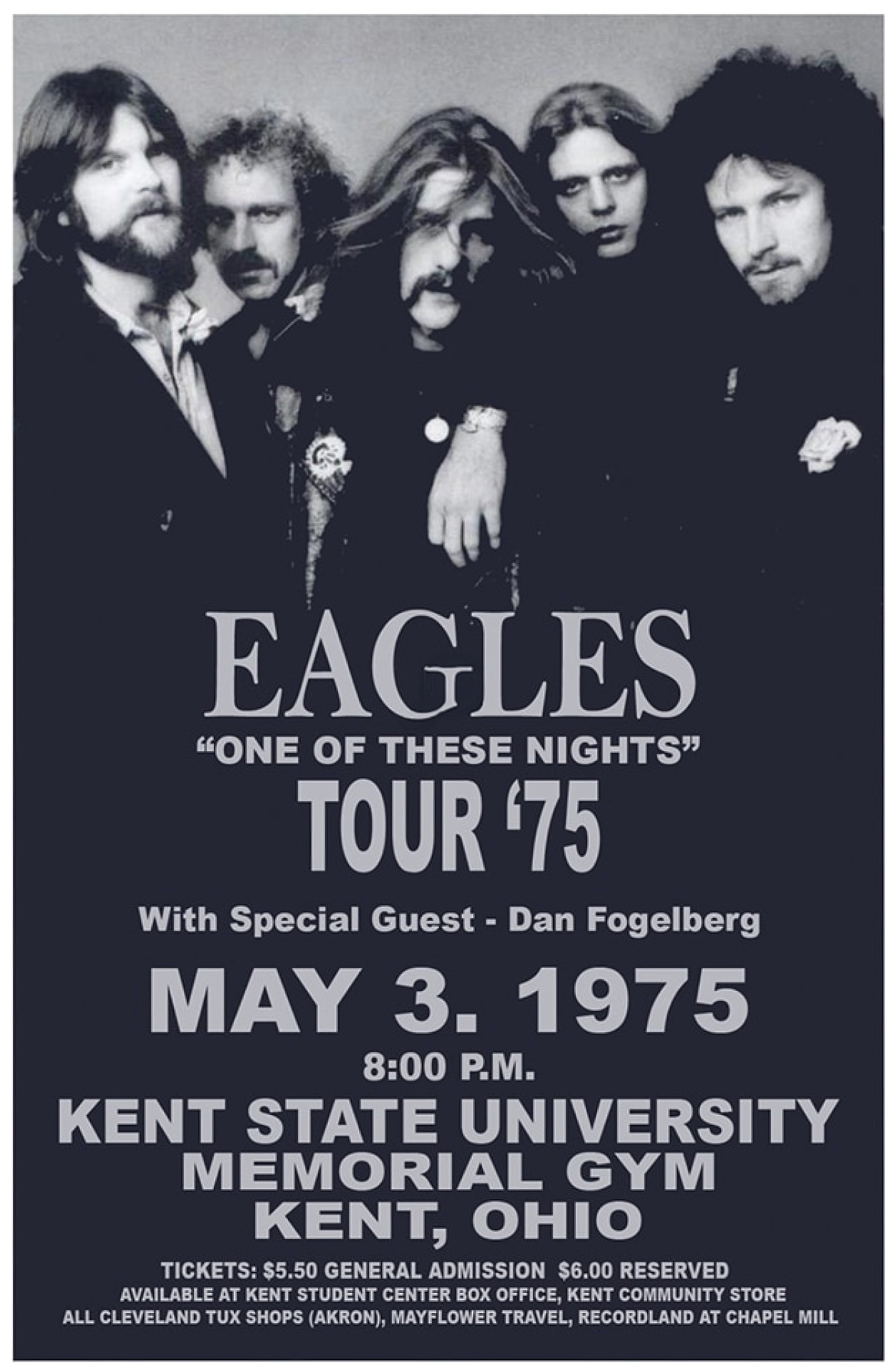
The 1980s
Concerts and events in the Memorial Gym became fewer in the 1980s because other places on campus, including the Kent Student Center Ballroom, University Auditorium and the Rathskeller, were better fits for crowds that would not fill a larger venue like the gym. Other contributing factors were changes in budget allocations, the rising costs of booking acts and the opening of the Coliseum in Richfield in 1974.
Oct. 17, 1982 The Clash
The Clash was on fire when they hit the stage in Memorial Gym, coming off an Oct. 9 appearance on Saturday Night Live and opening for The Who at Shea Stadium on Oct. 13.
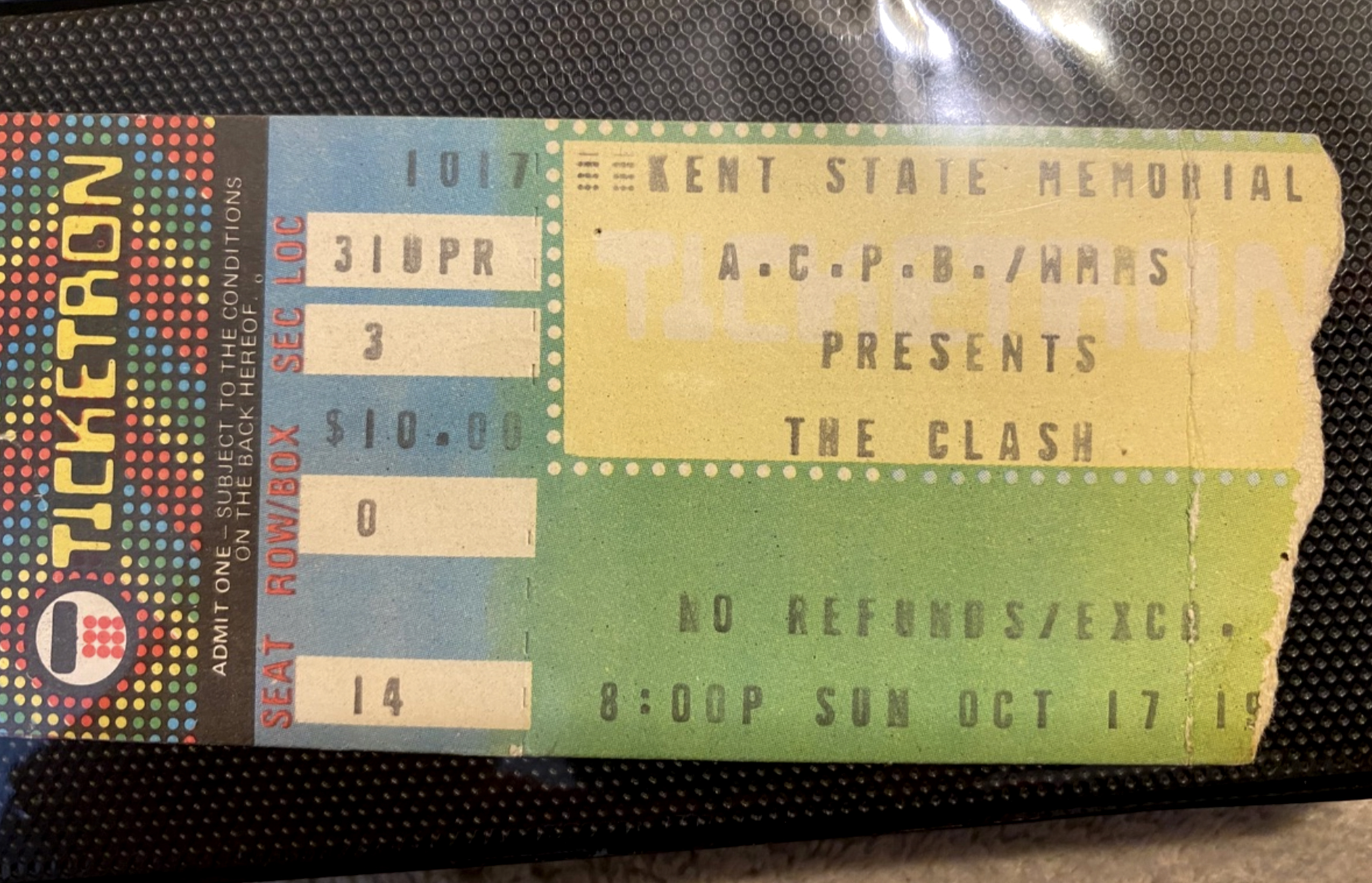
The 1990s
The 1990s started out with extensive renovations to the Memorial Gym and the renaming of the facility as the Memorial Athletic and Convocation Center. After reopening in 1992, the MAC Center’s first big concert was the sold-out Phish show in 1994. Kent State President Lester Lefton announced a new campus tradition – FlashFest – in 1995. In the coming years, FlashFest would be staged at multiple locations on campus, including the MAC Center.
Nov. 12, 1994, Phish
This show marked the triumphant rebirth of Memorial Gym as the Memorial Athletic and Convocation Center with a sold-out show and Phish fans taking over the parking lots at the Kent Student Center and the Michael Schwartz Center with a festival-like gathering. “It was like a carnival,” Prufer said. “It was a carnival that had come from all over the country to descend for just these six hours.” It was the MAC Center’s first big concert since reopening after the renovations and the first sold-out show since the Hall and Oates show in 1981.
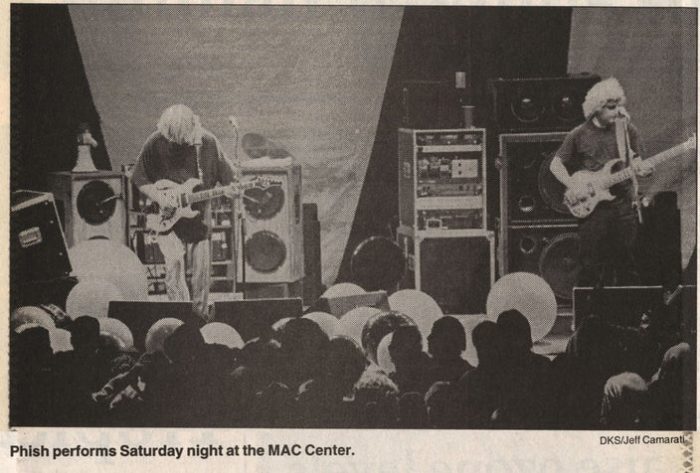
The 2000s
Until the 2000s, the relatively new tradition of FlashFest didn’t feature a big concert and was most often held outdoors. The first FlashFest concert at the MAC Center occurred on April 27, 2000.
April 23, 2000, Smashing Pumpkins
Brad Powell, who was the concerts chair for the ACPB, noted, “This size venue really worked for them. This is bigger than the Agora and smaller than the Cleveland State University Convocation Center.”
The 2010s
In the 2010s, some large events were staged on Manchester Field, Centennial Green and the newly created Student Green, sometimes with the MAC Center as a backup location if the weather was bad. The rafters of the MAC Center still regularly rocked with athletics events, concerts, comedians and the new Presidential Speaker Series, created by President Lefton.
Sept. 17, 2011, Mike Posner, DJ J-Breezy, Wale – and Machine Gun Kelly
Machine Gun Kelly was not on the bill for the evening – he just showed up. “He showed up at someone else’s show,” Prufer said. “He still lived in Cleveland and was the biggest thing in Northeast Ohio at the moment. And it was a year before he would fly off.”
Concerts at the MAC Center
From rock legends and chart-topping pop acts to country icons and groundbreaking tours, the MAC Center has hosted some of the biggest names in music history. This playlist brings those nights back to life, with one song from each of the 75 concerts that helped define the soundtrack of the past seven decades.
The Magic of the MAC Center
While a number of quantifiable factors – prime location, availability of funds and careful curating by student programmers – are responsible for bringing this impressive list of notable people and performers to the facility now known as the Memorial Athletic and Convocation Center over the past 75 years, there are some intangible influences as well.
Kent State alumnus Joe Walsh, guitarist for the Eagles, may not have been specifically referring to Kent State’s attraction as a performance venue, he may have touched on another element that could have drawn some of these famous names here when he pondered what the common link may have been.
“What brought all these people – those artists, photographers, poets, filmmakers and musicians – together? College,” Walsh said when speaking about Prufer’s book. “Kent State is what made Kent such a magical place at the time and what continues to make it special. And I would never be able to be where I am without that experience. It was just a magical time.”
